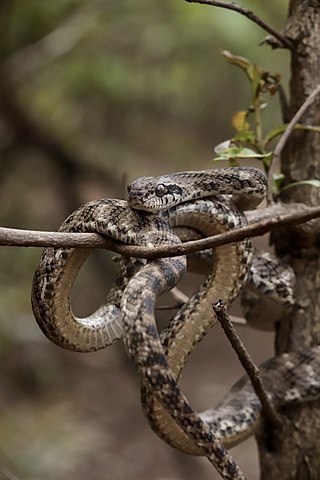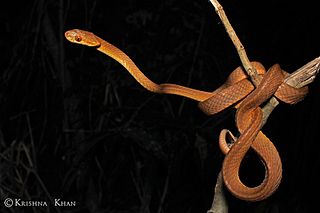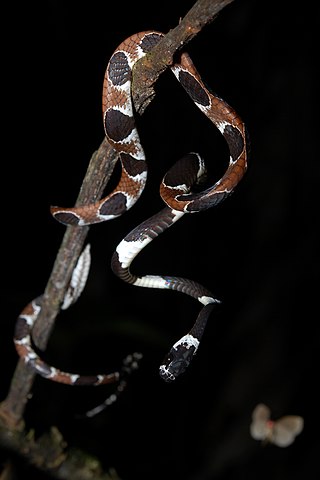
Boiga dendrophila, commonly called the mangrove snake or the gold-ringed cat snake, is a species of rear-fanged venomous snake in the family Colubridae. The species is endemic to southeast Asia. It is one of the biggest cat snake species, averaging 8–9 feet in length. It is considered mildly venomous. Although moderate envenomations resulting in intense swelling have been reported, there has never been a confirmed fatality.

Boiga dightoni, commonly known as Dighton's catsnake, the Pirmad cat snake, and the Travancore cat snake, is a species of rear-fanged mildly venomous snake in the family Colubridae. The species is endemic to the Western Ghats of India.

Boiga forsteni, also known commonly as Forsten's cat snake, is a species of mildly venomous rear-fanged snake in the family Colubridae. The species is endemic to South Asia.

Boiga ochracea, commonly called the tawny cat snake, is a species of rear-fanged snake in the family Colubridae. The species is endemic to South Asia.

Tantilla is a large genus of harmless New World snakes in the family Colubridae. The genus includes 66 species, which are commonly known as centipede snakes, black-headed snakes, and flathead snakes.
The slender Oldfield mouse is a species of rodent in the family Cricetidae. It is found in Ecuador and Peru.

The elegant stubfoot toad or Pacific jambato frog is a species of toad in the family Bufonidae found in lowlands and Andean slopes of northwest Ecuador to 1,140 m (3,740 ft) asl and on the Gorgona Island, off southwest coast of Colombia. It was described by George Albert Boulenger in 1882 based on a specimen collected by Edward Whymper. It is known in Spanish as rana jambato del Pacífico or simply jambato del Pacífico.

Dipsas is a genus of nonvenomous New World snakes in the subfamily Dipsadinae of the family Colubridae. The genus Sibynomorphus has been moved here. Species of the genus Dipsas are known as snail-eaters.

Catesby's snail-eater, also commonly known as Catesby's snail sucker, is a nocturnal species of nonvenomous snake in the family Colubridae. The species is native to northern South America.

Dipsadinae is a large subfamily of colubroid snakes, sometimes referred to as a family (Dipsadidae). They are found in most of the Americas, including the West Indies, and are most diverse in South America. There are more than 700 species.
Dipsas pratti, known commonly as Pratt's snail-eater, is a species of arboreal snake in the subfamily Dipsadinae of the family Colubridae. The species is endemic to northern South America.

Toxicodryas blandingii, commonly known as Blanding's cat snake and Blanding's tree snake, is a species of rear-fanged venomous snake of the family Colubridae. The species is endemic to Sub-Saharan Africa.

Stenorrhina degenhardtii, also known by its common name Degenhardt's scorpion-eating snake, is a species of snake in the family Colubridae. The species is native to southeastern Mexico, Central America, and northwestern South America. There are three recognized subspecies.
Dipsas jamespetersi is a non-venomous snake found in Ecuador and Peru.
Dipsas oligozonata is a non-venomous snake found in Ecuador.

Dipsas pavonina, the northern snail-eater, is a non-venomous snake found in Guyana, Suriname, French Guiana, Venezuela, Brazil, Colombia, Bolivia, Ecuador, and Peru.
Dipsas peruana, the Peruvian snail-eater or Peru snail-eater, is a non-venomous snake found in Peru, Venezuela, and Colombia, Ecuador, and Bolivia.
Dipsas vermiculata, the vermiculate snail-eater, is a non-venomous snake found in Ecuador, Peru, and Colombia.
Incaspis simonsii is a species of snake in the family Colubridae..












